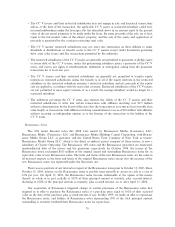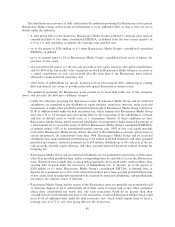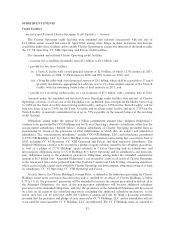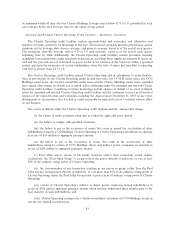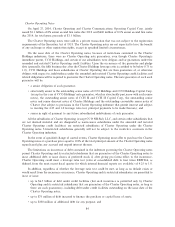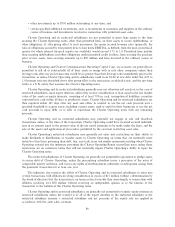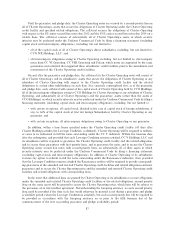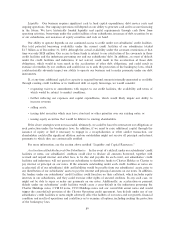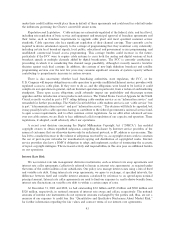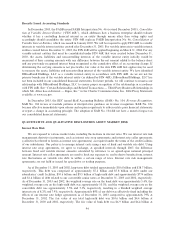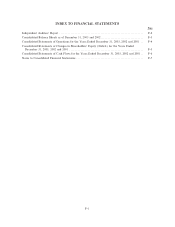Charter 2003 Annual Report Download - page 91
Download and view the complete annual report
Please find page 91 of the 2003 Charter annual report below. You can navigate through the pages in the report by either clicking on the pages listed below, or by using the keyword search tool below to find specific information within the annual report.Liquidity. Our business requires signiÑcant cash to fund capital expenditures, debt service costs and
ongoing operations. Our ongoing operations will depend on our ability to generate cash and to secure Ñnancing
in the future. We have historically funded liquidity and capital requirements through cash Öows from
operating activities, borrowings under the credit facilities of our subsidiaries, issuances of debt securities by us
or our subsidiaries, our issuances of equity securities and cash on hand.
Our ability to operate depends on our continued access to credit under our subsidiaries' credit facilities.
Our total potential borrowing availability under the current credit facilities of our subsidiaries totaled
$1.7 billion as of December 31, 2003, although the actual availability under the covenant restrictions at that
time was only $828 million. Our access to those funds is subject to our satisfaction of the covenants in those
credit facilities and the indentures governing our and our subsidiaries' debt. In addition, an event of default
under the credit facilities and indentures, if not waived, could result in the acceleration of those debt
obligations, which would in turn result in the acceleration of other debt obligations, and could result in
exercise of remedies by our creditors and could force us to seek the protection of the bankruptcy laws, which
could materially adversely impact our ability to operate our business and to make payments under our debt
instruments.
If, at any time, additional capital or capacity is required beyond amounts internally generated or available
through existing credit facilities or in traditional debt or equity Ñnancings, we would consider:
‚ requesting waivers or amendments with respect to our credit facilities, the availability and terms of
which would be subject to market conditions;
‚ further reducing our expenses and capital expenditures, which would likely impair our ability to
increase revenue;
‚ selling assets;
‚ issuing debt securities which may have structural or other priorities over our existing notes; or
‚ issuing equity securities that would be dilutive to existing shareholders.
If the above strategies were not successful, ultimately, we could be forced to restructure our obligations or
seek protection under the bankruptcy laws. In addition, if we need to raise additional capital through the
issuance of equity or Ñnd it necessary to engage in a recapitalization or other similar transaction, our
shareholders could suÅer signiÑcant dilution and our noteholders might not receive all principal and interest
payments to which they are contractually entitled.
For more information, see the section above entitled ""Liquidity and Capital Resources.''
Acceleration of Indebtedness of Our Subsidiaries. In the event of a default under our subsidiaries' credit
facilities or notes, our subsidiaries' creditors could elect to declare all amounts borrowed, together with
accrued and unpaid interest and other fees, to be due and payable. In such event, our subsidiaries' credit
facilities and indentures will not permit our subsidiaries to distribute funds to Charter Holdco or Charter to
pay interest or principal on our notes. If the amounts outstanding under such credit facilities or notes are
accelerated, all of our subsidiaries' debt and liabilities would be payable from our subsidiaries' assets, prior to
any distribution of our subsidiaries' assets to pay the interest and principal amounts on our notes. In addition,
the lenders under our subsidiaries' credit facilities could foreclose on their collateral, which includes equity
interests in our subsidiaries, and they could exercise other rights of secured creditors. In any such case, we
might not be able to repay or make any payments on our notes. Additionally, an acceleration or payment
default under our subsidiaries' credit facilities would cause a cross-default in the indentures governing the
Charter Holdings notes, CCH II notes, CCO Holdings notes and our convertible senior notes and would
trigger the cross-default provision of the Charter Operating credit agreement. Any default under any of our
subsidiaries' credit facilities or notes might adversely aÅect the holders of our notes and our growth, Ñnancial
condition and results of operations and could force us to examine all options, including seeking the protection
of the bankruptcy laws.
89


